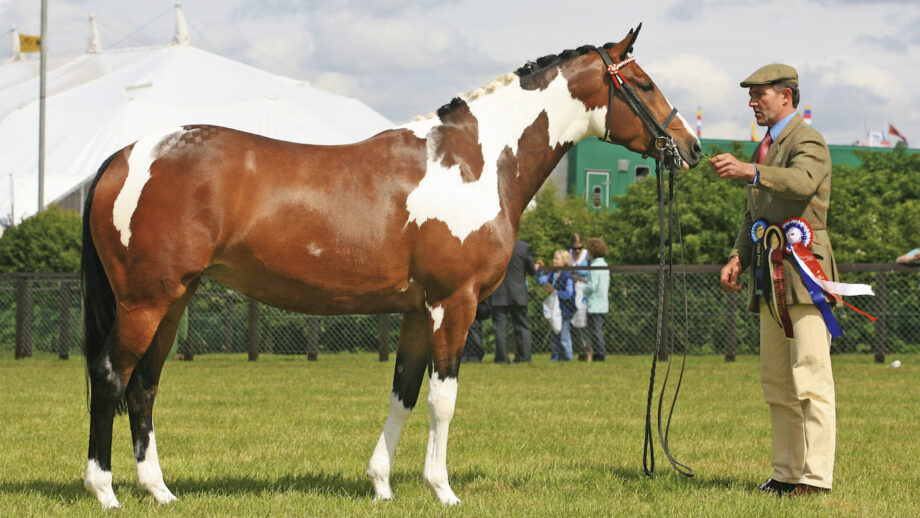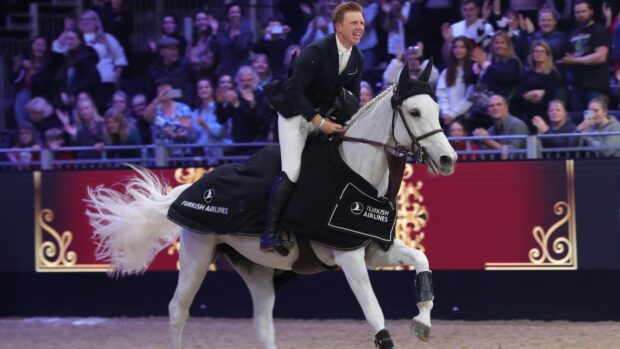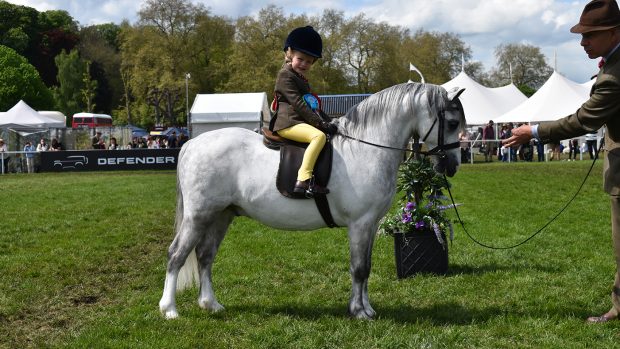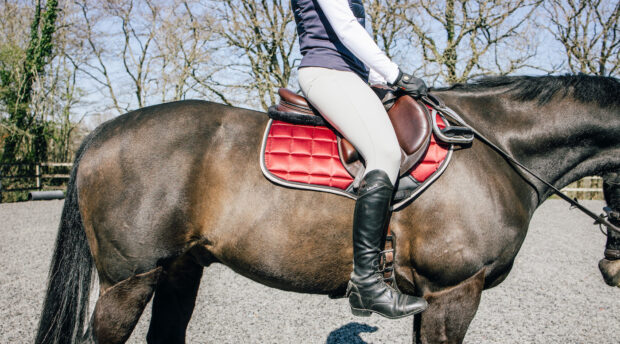Training plaited ponies for success in show and show hunter pony classes this season requires both your young jockey and their pony to have done their homework over the winter. Meticulous preparation will go a long way in ensuring their success this summer.
Whether your child is moving from a first-ridden onto a 128cm show pony, or they’re foraying into their final show hunter pony height section, refining the pony’s way of going and the rider’s ringcraft and showmanship is key to improve their odds in these highly competitive classes.
Show pony and show hunter pony classes are only open to children and younger riders, with both sections having age restrictions. Show ponies are sectioned in the following heights; 128cm, 138cm and 148cm. Hunter ponies are split into four height categories; 123cm, 133cm, 143cm and 153cm. The main championships for both sections are at the Horse of the Year Show and the Royal International Horse Show, though there are countless opportunities for children to compete their ponies across the country on the local, national and county circuits.
The show pony, also known as the children’s riding pony, must be suitable of carrying a child or young teenager safely in the ring. They must display exceptional manners, quality conformation, elegant yet straight movement and added sparkle and presence that is desired in all show animals. The hunter pony is a more substantial animal in type but must also be suitable for a young person to pilot. The hunter pony must be workmanlike but with quality and must go freely forward but safely and with manners. H&H has two detailed guides on what to look for in show ponies and show hunter ponies.
6 focus points for training plaited ponies
If you have children training plaited ponies in preparation for the coming show season, then these tips from two of the circuit’s most established pony producers are sure to help.
1. Practice makes perfect
Adam Forster co-runs Team Jinks with David Jinks in Cheshire. Adam and David have produced a myriad of HOYS and RIHS winners. In 2024, their charges finished supreme and reserve supreme pony at the RIHS final. Their supreme was 153cm show hunter pony contender Rosscon Copycat (Reise Shakespeare) and their reserve was lead-rein hunter pony Newoak Midnight Blue (Violet Mennie).

Lead-rein hunter pony Newoak Midnight Blue. Credit: Alex Robinson
Adam believes that ensuring a new combination gets out and about during winter is essential.
“A new partnership can initially look out of their depth in the ring, especially if the child is younger and is moving up a class,” Adam says. “They can go into the ring with a feeling of trepidation, not wanting to get it wrong, especially if they’ve had a lot of success in a previous class, such as on the lead-rein. There’s nothing that can really fix this aside from time in the ring.”
Adam recommends using the winter circuit to your advantage.

Winter shows pave the way for summer success. Credit: Trevor Meeks
“Get as many winter and spring shows and clinics in as possible,” Adam suggests for those training plaited ponies. “Go to a training clinic where they will replicate a show situation, such as cantering on the go-round. This gives you a starting point and you can see what needs work.
“If you can’t afford to go to a clinic every week, invite friends over or go to their place. At the weekends we have all the kids to the yard to ride and we’ll often line up and do a show. We all get it wrong, even me! But this is the time to make mistakes – go on the wrong leg, canter too fast on the go-round. Nothing is ever a failure if you learn from it.
“Then, use the multitude of shows we have access to and don’t be afraid to ask for help from professionals, trainers and so on. The only way to overcome the appearance of a novice combination is time in the saddle and repetition. You can read all the books in the world and watch as many classes or demonstrations as you like, but actually doing it is the only way to really learn.”
2. A consistent contact
A pony which is not settled in the head and looks unhappy in the mouth can spoil the picture. Adam says that going back to basics with both pony and rider is the way to move forward.
“You may start a novice and after an outing or two they may go a bit fussy in the contact,” Adam says. “Look at this situation with open eyes. Often, we’ve got our best jockey on so it’s unlikely to be an issue with the hands, but it might be that the pony needs re-mouthing and long-reining for a while.
“At no point in a horse or pony’s career would I say it’s too late to re-mouth,” Adam confirms. “I am always open to popping a pony back in a breaking bit and sticking them on the long reins for a week or two. They can all go a bit wooden and stale, and this softens them, helps them regain confidence in the contact and refreshes things. Long reining helps the horse to engage their core, use their hindleg and come up in front, if done well. Taking things back a few steps can really push things forwards in the long run.”

If the pony is fussy in the mouth, it may need to go back to the basics. Long-reining – as demonstrated by this horse and handler – helps refresh the work routine and give the pony confidence in the contact. Credit: Shelley Photography
Sometimes, a rider’s lack of security in the saddle is the reason for an inconsistent contact.
“If a rider has not developed a strong, independent seat, then this will cause them to have loose hands and consequently they can’t maintain a contact,” Adam says. “In this instance, I would get the rider to ride without stirrups for a period of time. I’d pop them on the lunge with a neck strap for a couple of weeks, I’d get them to put one hand out to the side with the other on the strap. It’s basic stuff, but it really develops that strong, deep seat that is required. If you have a strong and independent seat, you shouldn’t even need the hand and should be able to turn and circle the horse with just the seat and legs.”

Training the young rider is every bit as important as the pony – ridden work while on the lunge can help develop an independent seat. Credit: Alamy
“I tell my jockeys to imagine they are holding a bunch of flowers. Then, take one flower out of that bunch. The amount of pressure you would use to take that flower out is the same amount you should have on the reins – not very much at all.
“I take my own stirrups away a couple of times a month, and my top rider Jack Owen is always riding without stirrups.”
3. Using the neck strap
“I am never too proud to use a neck strap,” Adam says. “A neck strap can be a helpful tool, whether jumping, riding a fresh one or cantering for the first time on a novice, and it can get you out of a million different problems. You can use it for safety in potentially sticky situations, but also for balance so you don’t accidentally pull the horse in the teeth.”
4. Getting the right leg
Rachael Helliwell is based in Cumbria and her show team have produced multiple HOYS and RIHS winners and champions across the sections.
For smaller riders experiencing cantering in the show or on the go-round for the first time, picking up on the right leg on both reins can take time to perfect, especially if their partner is a novice pony.
While it can be tempting to ask the jockey to look down to their inside to check if they’re on the right leg, Rachael advises against this when training plaited ponies and their young riders as it causes unbalance and can become a habit.
“You can teach the jockey how to ‘feel’ if they’re on the right leg by repetition,” Rachael says. “Ask them to pick up, and then ask them to feel it, or change if they’re wrong and feel again. Eventually, they will learn how the right leg feels.
“Some children struggle more than others, and this means that, as a producer, I would work the pony with another rider so he can pick up on the right leg pretty much every time asked. This is established by the pony being balanced and working with the correct bend, though this is obviously a work in progress with a young pony.
“Looking down for the correct leg, as with checking for the diagonal, can become a bad habit. Plus, the child needs to be looking where they’re going! If you repeat the process of correcting the rider yourself on the ground they will get it; it will usually take a child between six months and a year to learn the feel.”
5. Building balance
Rachael credits her location for building her string of ponies’ balance and stamina. Meg Edmondson’s Team Helliwell-based Briarhill Buddy Bolden was a dual champion at HOYS in 2024. His main form of exercise was working on the hills behind the yard.

Briarhill Buddy Bolden, a double HOYS intermediate winner. His producer Rachael Helliwell credits hillwork for his balance and stamina. Credit: Peter Nixon
“We are very thankful for those Cumbrian hills,” Rachael says. “We do lots of hacking and hill work. We walk up and down, trot up and down, also standing at the bottom to improve manners. At first, youngsters struggle to go down the hill until they build their strength.
“When it comes to canter, I’d always let a pony find their balance first by giving them their head and popping them on a big circle,” Rachael adds.

Team Helliwell out hacking their ponies on the Cumbrian hills. Credit: Real Time Imaging
6. Confidence is key
“Some young riders naturally have confidence, others have less and can go into the ring a bit defeated before they’ve even begun,” Rachael says. “Therefore, we always instil confidence and a sense of sportsmanship and competitiveness in our riders from the very beginning of their careers.”
When training plaited ponies, Rachael teaches “most kids in groups”.
“All of them will come to the yard together and will ride in the same lesson. I find they all immediately up their game trying to impress – they’re effectively competing for attention, as they would be in the ring. Each rider always wants to be the best and get the praise! They get used to riding in a group, too, as they need to be looking ahead for a space and being mindful of others.
“I also ask most of the kids to ride different ponies so they get used to how others feel. This often gives them more appreciation and respect for their own pony! Swapping and changing helps them become more developed riders and they grow in confidence.”

A happy, confident child enjoys the rewards of their hard work. Credit: Alamy
Thank you for subscribing to the H&H website. We will be bringing you showing news from major dates on the circuit including Royal Windsor, Royal Welsh, Royal International, HOYS and more, as well as important news that the showing world cares about throughout the year. Stick with us for all you need to know.
You may also enjoy reading…

Little steps for big results: lead-rein producers share their winning formulae for the show ring’s budding stars

Solve these six common cob problems to give you the edge in the show ring this season

7 homework lessons for first-ridden combinations to build confidence and success for the new season

Be ready to win with expert tips on last-minute planning and polish to ensure a successful show ring debut in 2025

Look at me, judges! Expert tips on preparing your show horse to stand out in the ring for all the right reasons this season





